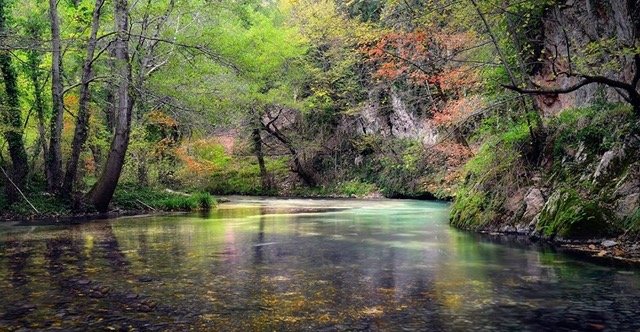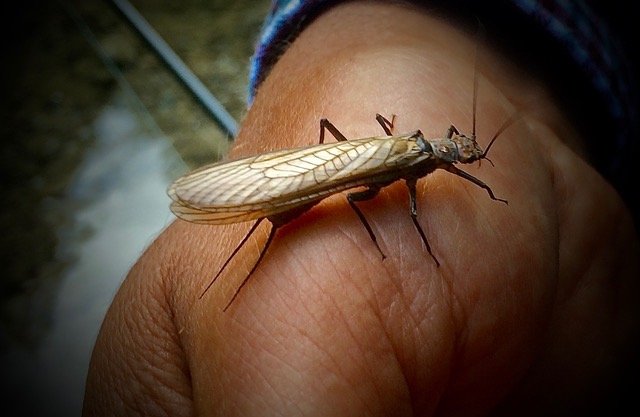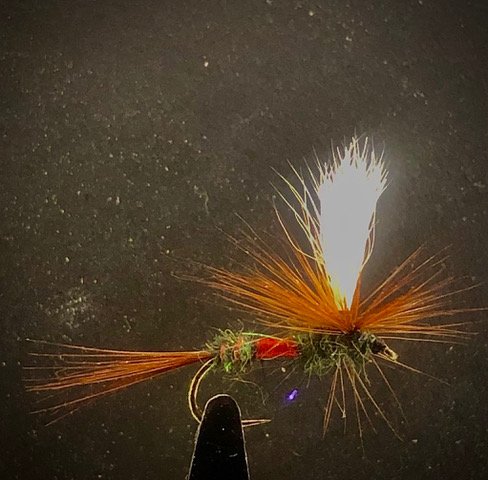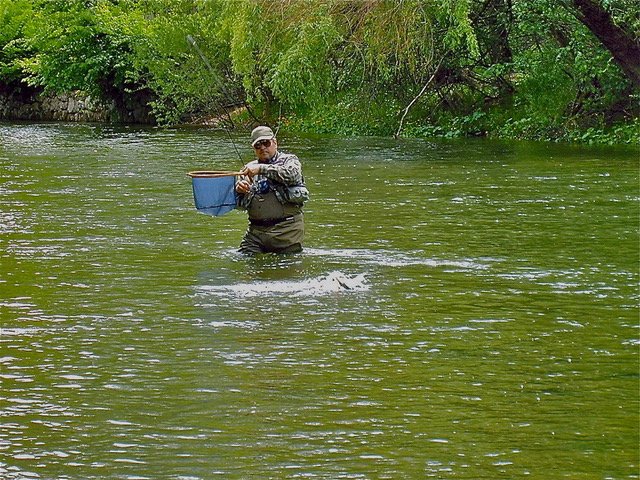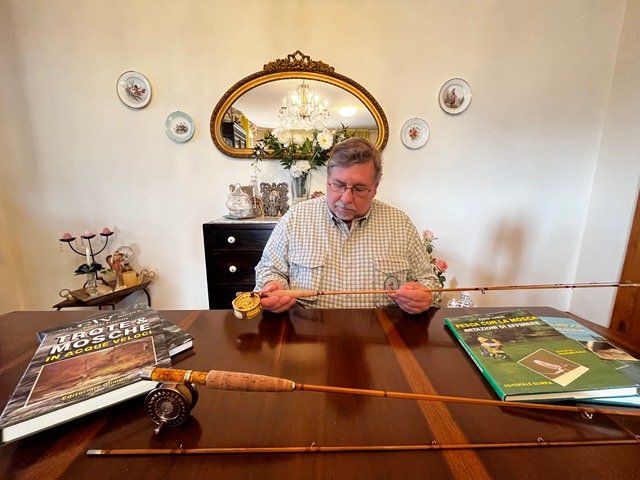
Siro Vescarelli
Translation is Giorgio Vescarelli
1) CHOICE OF EQUIPMENT: RODS, REELS, FLY LINES, FLY FLOATANTS, CLOTHES, GLASSES AND OTHER USEFUL ITEMS:
Rods : Until 2018 I used graphite rods, preferring for my rivers lengths of 7'6 "ft 8 'ft per line # 3 # 4.
This is because although I am not a good fly caster, my casting style incorporates the concepts of the Italian style, which involves the use of 7'-7'6 "and 8 short rods.
From 2018 I started building bamboo rods with suitable taper for my casting style, therefore rods with fairly hard butt and very fast, sensitive tips (for what the material allows) designed to have a good efficiency in casting, combined with the pleasantness of bamboo.
Having managed to build bamboo rods with the characteristics I was looking after, since two years I’m fishing only with them, using lengths between 6'6 "and 8 'with powers between # 3 and # 5/6 (I mainly use a 6'9" # 3 and a 7' # 4/3, I only use the 7 ' 6 "# 5 and 8 '# 6 in big rivers, specially when I go on fishing trips)
Reels:
I am a big fan of old reels which, thanks to their retro look, match well with my rods. I mainly use:
-Hardy Sovereign 3/4
-Orvis Battenkill Disc 5/6 years 90
-Marryatt MR 7
Fly Lines:
I mainly use DT3f and DT4f because they are the ones that adapt to my fishing style.
My favorites were the Ultra 2 and 3 from Scientific Angler but since they have been discontinued I haven’t found any substitute that match my needs.
Fly Floatants:
I mainly use silicones both in gel and liquid that can be used independently both on flies in hackles and in CdC for this reason I find Tiemco Dry Magic very good.
Clothes:
I am not a "fashion addicted" to fly fishing apparel, I prefer looking for the technical value and comfort than a fancy design of some “trendy” brand.
Glasses:
Being myopic I use graduated polarized glasses, made to measure, or Polaroid lenses that can be attached over prescription glasses.
2) LEADER MATERIAL, BUILD UP, LENGTH AND KNOTS
I use Knotless leaders of 12ft 2X-3X and 15ft 3X-4X which I modify by cutting almost completely the tip part. There are about 30-25 cm left, to which, through a blood knot, I add 25/20 cm of nylon 0,20 / 0 , 18 mm at the end of which I make a small button hole with a perfect knot. To this modified end I add a tip of variable length from 1.2m to 1.8m of the necessary diameter (from 0.16mm to 0.10mm) by tying it to the loop using a klinch knot. Now, on the market, there leaders with these characteristics and ready to use produced by my friend Massimo Magliocco.
3) APPROACH AND STEALTH
My approach to the spot is mainly Upstream. In the rivers where I usually fish, characterized by fast waters, such as the Nera for example, there are often no rises but the fish, if properly stimulated, would still go up to catch the fly.
Because of this in Italy we have developed our own style of fishing in which the approach and discretion play a fundamental role, we call this technique, that makes great use of the fisherman's sense of water, “Fishing in Hunting” for the way we hunt for fish.
A wrong approach often means to compromise the success of your action.
In fast waters the trout does not give you a second chance so even if we managed to get close to the fish without alarming it, a wrong launch can vanity everything that has been done before.
4) READING THE WATER
Here in Italy we call it “the sense of water”, it’s referred to the ability of understanding where the fish is, if it is active, what it is eating at that moment and what are the current flows it uses to feed itself without wasting too much energy.In chalkstreams and rivers in which the fishes are “rising” is easier to understand these things because you are being helped by the sight, looking at the circles in the water surface for example. Instead in streams with fast waters or in rivers with no rising it is necessary to have reached such a high degree of experience that just by observing the small signals that the river provides it is possible to understand which are the hunting positions of the fish and the trajectories of the food. Also observing the life of the river, for instance the insects that could be preyed upon, a skilled fisher can get clues. So in fast waters, as I said in the previous question, with our "Fishing in Hunting" technique, knowing how to read the water is essential.
Photo: Sergio Mastriforti
5) CASTING ABILITY WICH CAST ARE ESSENTIAL
Italian fly fishermen, especially those who like me come from the Central/Southern regions, are almost all in debt to the great Roberto Pragliola, the man who with his master-classes and his books directed us towards his casting style called “TLT” (Tecnica Lancio Totale/Total Casting Technique). Later also other great fly-fishermen made an impression on us always following that idea of launch: I can mention Fosco Torrini who has collaborated with Roberto Pragliola since the beginning, Giampiero Bartolini who co-founded the “TLT Academy” with him and Massimo Magliocco with his masterclasses. Although I am not a master in casting, I made those notions my own trying to use them to lay the fly before the tip and using the various types of casts: curved, slowed down, undrtip, which Pragliola has codified over time, to enter under the vegetation and to avoid dredging that would be totally negative for catching the fish.
For those who want to learn more about this way of casting, there are various books Pragliola himself, the latest ones are “Magie Sull’Acqua" and “La Pesca Con La Mosca" which are still available on the market. Personally I am convinced that in rivers and streams with fast waters when "fishing in hunting", presenting a fly in a perfect way is much more important than the choice of the fly itself, while fishing in chalk streams and rivers with slow currents and very selective fish, in addition to goodness of presentation (resulting from a perfect cast), is necessary the careful choice of the fly.
6) ENTOMOLOGY WHAT SHOULD WE KNOW
I have always had interest in building flies, both classic and my own designs.
I believe that to become a good fly-tier is needed a basic knowledge of entomology, specially referring to insects that normally could be met on the fishers go-to rivers.
I’m not saying that I have university-degree type of knowledge, but the one needed to discriminate and know the characteristics of the main insect families.
To me a good fly-fisherman should build his own flies and to do it correctly he shouldn’t only know a little bit of entomology but even the basics of fly-tying history. Knowing the old dressings and being able to adapt them to modern materials you can build deadly flies.
7) RISE FORMS CAN THEY TELL US SOMETHING
Surely from the shape of the rises and the way in which they occur you can have valid indications on what the fish is eating at that moment, and if it does it on the surface or below the surface of the water. This gives us indications whether to use imitations that work on the surface or imitations of emerging insects or even mature nymphs about to flicker.
It’s easier to find these situations in chalk streams or rivers with slow current rather than in streams with fast water, in which they are limited to the rare areas with slow water.
I found a lot of help in the recognization of rises from the book “The Trout and the Fly. A New Approach ” written by Brian Clarke and John Goddard, this made me understand a lot about how to feed on trout.
8) FLY SELECTION, SIZE, SHAPE, MATERIALS, WICH FLIES ARE ESSENTIAL
This is one of the topics I prefer, fly tying and rod building are the aspects that fascinate me the most. I’d like to begin saying that to fish in my go-to rivers I use many attractive search flies such as Royal Wulff, Devaux 699, Panama, Adam's, March Brown, Royal Stimulator etc. etc.
I tie this flies with dressings more suitable for fast Italian casting such as the Parachute assembly. I also use a series of “soft flies” designed on my own using the CdC and other soft materials mixed with the hackles, then divided under the chest for a greater support consequently using a
smaller mass of Hackles / CdC. To do this I use a montage called Split Hackles, which I first saw in the 90s in magazine articles by Raffaele De Rosa. I also use Sedge models a lot, I build them using both feathers and CdC as well as deer hair or other ungulates. In rivers with slow current or chalk streams I use mainly artificial in CdC. Among the flies for fishing on the rises I start from emerging nymphs, emerging ephemeral and tricoptera, ephemeral at the stage of dun, spent, trichoptera and plecoptera in deposition up to use in their presence imitations of winged ants or chironomidae and diptera. In my fishing trips, in large rivers or chalk streams, I usually bring the construction material with me so I’ll be able to build flies that are suitable for that environment. The materials I prefer are mostly natural materials like hair and feathers, which I sparingly mix with synthetic materials, I do this specially for the yarns and for the polypropylene that I use for the wings. I cannot say which flies are essential because they can vary from river to river, as I’ve already said a good knowledge of classic dressings and a basic entomological knowledge can help a lot, however I do not leave home without having 3 or 4 Royal Coachman Parachute or for the rivers with rises 3 or 4 ARPO (an Italian fly in CdC that imitates emergent ephemeral or tricopter) in my box.
9) PRESENTATION AND DRIFTS
A good presentation is essential to be able to catch the fish. It’s essential in fast waters and even more in the slow ones. The fundamental thing is trying to bring first the fly into the visual of the fish and then the rest of the leader. I try to use this throwing sideways to the fish (when possible) or, in the case of upstream fishing, using slowed and curved casts.
Sometimes (specially in slow waters) a slight movement of the fly can be attractive towards a fish that has proved apathetic, however using terrestrial or sedge (which once in the water wriggle to be able to reach the shore) a slight dredging at the end of the stroke is certainly very attractive to fish.
10) UPSTREAM OR DOWNSTREAM ?
I mostly catch trouts, so I prefer upstream because, as you know, the trout needs oxygen and therefore it always positions itself with the nose against the current (unless it’s in a particular position where a whirlpool of water causes it to face downstream) so coming from behind I’ll more likely not to be seen. If, on the other hand, I fish graylings I prefer to fish sideways to them by casting slightly downstream, this to ensure that the tip will not be seen by the fish.
11) FIGHTING FISH.
Normally I happen to fight trout of a length between 25 to 35 cm so the fights are always very short, when instead I am kissed by luck and I find myself fighting with a nice fish using a thin tip I try to fight it by keeping the rod low and perpendicular to the fish to take advantage of its elasticity and trying to accommodate the fish’s escapes as much as possible, both using the drag of the reel and following its movements (when possible). A good landing net concludes the fight. In case the fish deserves a photo, to remind us of our lucky day, I recommend not to touch it with your hands and keep it into the water as not to harm the fish.


